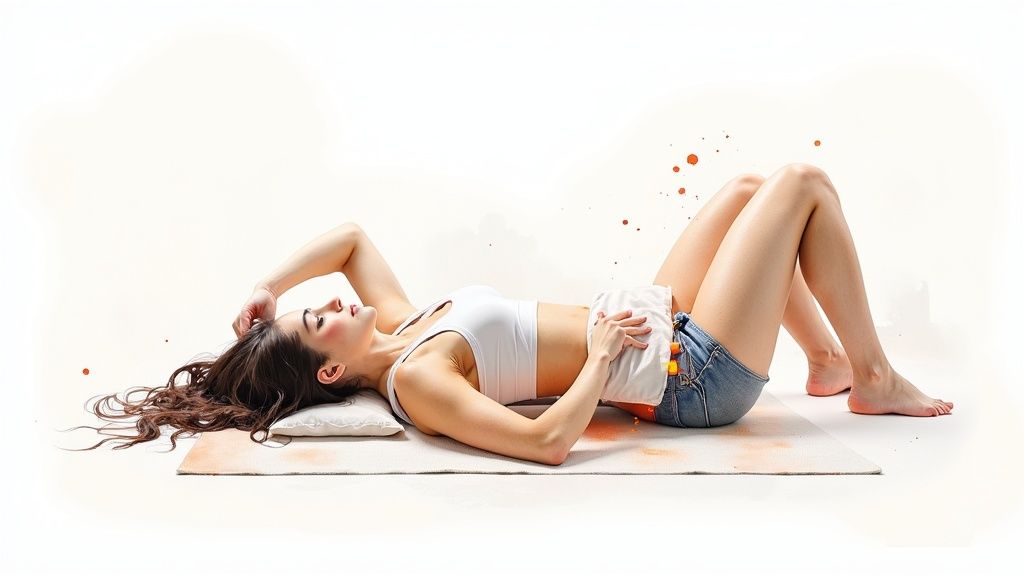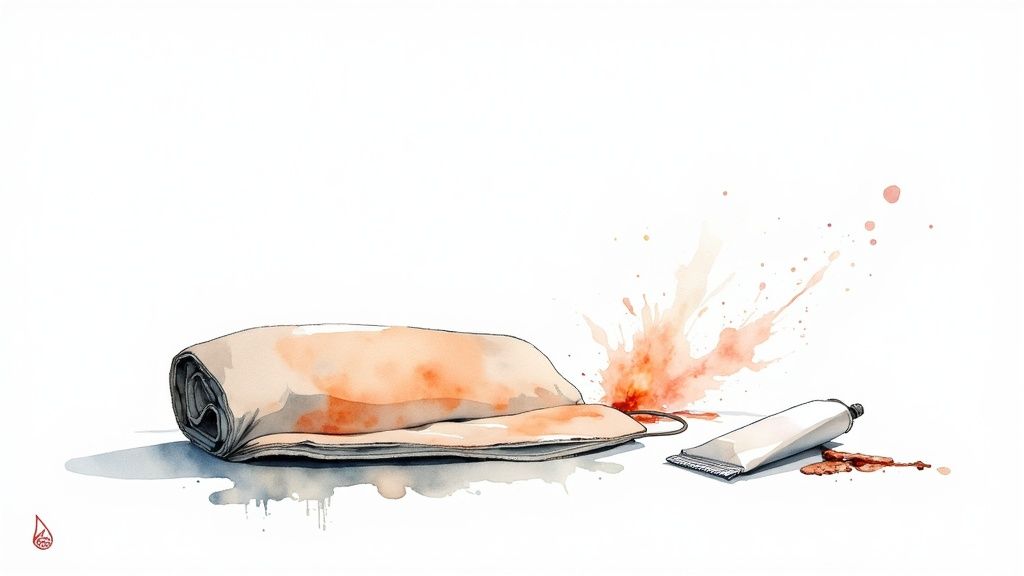Your Guide to Complete Heating Pad Safety
-
Proper heating pad safety isn't complicated. It really boils down to using it for short, focused sessions—think 15-20 minutes at a time—and always, always putting a barrier like a towel between the pad and your skin. Never use a heating pad on broken skin, and whatever you do, don't fall asleep with one on. It's also a no-go for areas where you have poor sensation.
The Real Benefits of Safe Heat Therapy
Heating pads are so much more than just a cozy gadget for a chilly evening; they're a legitimate tool for managing pain and helping your body relax without medication. When you feel that gentle warmth spreading across a sore muscle, what's actually happening is a process called vasodilation.
The heat encourages your blood vessels to open up, which ramps up circulation right where you need it most. This boost in blood flow is fantastic because it ferries more oxygen and nutrients to damaged tissues, helping to kickstart the healing process.

Better circulation also helps your body flush out the waste products that cause soreness, like the lactic acid that builds up after a tough workout. On top of that, the warmth can have a calming effect on nerve endings, which helps to block pain signals from ever reaching your brain.
Unlocking Comfort in Everyday Life
The practical uses are endless. Imagine finishing a stressful day with a stiff neck. Applying a heating pad for 20 minutes can melt that tension away, often more effectively than a painkiller. Similarly, pairing heat therapy with gentle massage therapy can be a game-changer for chronic conditions. The heat loosens the muscles, making the massage more effective and providing longer-lasting relief from persistent aches.
It's clear people are catching on. The global heating pad market was valued at an impressive USD 54.13 billion, and it's expected to climb to USD 81.21 billion by 2032. That's a lot of people looking for safe, effective ways to feel better without reaching for a pill bottle.
The principle here is simple: warmth soothes. It eases muscle tension, makes you more flexible, and provides a deep sense of comfort that genuinely improves your quality of life.
But getting these benefits all comes down to one thing: using your heating pad safely. If you're not careful, you could end up with burns or skin damage, which completely defeats the purpose. This guide is here to give you the confidence to use heat therapy the right way.
For a deeper dive, you can explore our detailed article on the many benefits of heat therapy. In the next sections, we’ll lay out all the essential rules for safe, effective, and worry-free relief.
How to Choose a Safer Heating Pad
Finding the right heating pad is about more than just marketing claims. You’re choosing a tool for your well-being, so focusing on its core safety features is the most important step you can take.
Before you even think about size or fabric, flip the box over and look for a safety certification. This little mark is your proof that the product has gone through serious, independent testing for electrical and fire safety. Keep an eye out for a UL (Underwriters Laboratories), ETL, or CE mark on the packaging or the product tag. A certified product is your first line of defense.
Key Features That Matter
Beyond that initial certification check, there are a couple of features I consider non-negotiable for safe use. The first is an automatic shut-off timer. It’s so easy to get comfortable and drift off, and this feature is your safety net. It prevents the pad from overheating, dramatically cutting down the risk of burns or even a fire. Look for models that offer clear timer settings, typically shutting down after 30 to 120 minutes.
Next, insist on multiple, precise heat settings. A basic "low/high" switch simply isn't good enough. Having at least three distinct temperature levels lets you dial in the lowest effective temperature for your specific pain, which is crucial for preventing skin damage. For example, you might need a medium setting for deep-seated back pain but a much gentler, lower setting for your neck.
This infographic breaks down the very benefits you're trying to achieve by using heat therapy safely.

As you can see, the goal is always comfort and relief—and that's only truly possible when safety comes first.
When you're comparing models, it's easy to get lost in the details. I've put together this quick-reference table to help you focus on what really matters for your safety.
Essential Safety Features for Your Next Heating Pad
| Safety Feature | Why It's Critical | What to Look For |
|---|---|---|
| Safety Certification | Independent verification that the product meets stringent electrical and fire safety standards. | Look for UL, ETL, or CE marks on the packaging or product label. |
| Auto Shut-Off Timer | Prevents overheating and potential burns if you fall asleep while using the pad. | A timer that can be set for 30-120 minutes is ideal for most users. |
| Multiple Heat Settings | Allows you to use the lowest effective temperature, reducing the risk of skin damage. | At least three distinct settings, not just a simple "low/high" switch. |
| Durable Cord | A frayed or damaged cord is a major fire and electrical shock hazard. | A thick, reinforced cord, especially at the point where it connects to the pad. |
Think of these features as your personal safety checklist. Don't compromise on them.
Electric vs Microwavable Options
Finally, think about which type of heating pad makes the most sense for you. Electric pads give you consistent, long-lasting heat but carry the risks that come with cords and electrical parts. Microwavable pads, on the other hand, deliver a deep, moist heat without any cords attached.
One of the best things about microwavable pads is that their gradual cooling acts as a built-in safety feature, naturally preventing the kind of prolonged, high-heat exposure that can cause burns. If you're weighing your options, our guide comparing electric vs. microwavable heating pads can help you make the right choice.
When you prioritize features like UL certification, an auto shut-off timer, and variable heat settings, you're making a conscious decision to choose a product that delivers relief without the risk. That careful selection is what lets you truly relax and get the full therapeutic benefit from the heat.
Best Practices for Using a Heating Pad Safely
So, you've picked out a quality heating pad. That's the first step. Now, let's talk about how to use it correctly. This isn't just about getting the best pain relief; it's about making sure every session is completely safe. When you get this part right, your heating pad becomes a reliable go-to for comfort and relief.
Start Low and Go Slow
The biggest mistake I see people make is cranking the heat up to the highest setting right away. Don't do it. Always start on the lowest setting for about 10 minutes to see how your skin feels. Everyone's heat sensitivity is different, and this little test run helps you find your "just right" temperature without risking a burn.

This gentle, gradual approach works wonders for chronic pain like arthritis. Someone with stiff, achy hands will often get far more benefit from a low, steady warmth than they would from a short blast of intense heat. It’s all about consistency.
Always Use a Barrier
Putting a heating pad directly on your skin is a recipe for disaster, even on a low setting. You absolutely need a layer between you and the heat source. A thin towel, a folded t-shirt, or the soft cover that came with your pad will do the trick.
This buffer is non-negotiable. It helps spread the heat more evenly and protects your skin from direct thermal energy that can cause damage over time. Think of it as a mandatory safety shield. For smaller, portable options that often come with their own covers, you can check out how to properly use a reusable hand warmer in the microwave.
The "20 On, 20 Off" Rule is Golden
For the best results without any of the risks, live by the 20-minute cycle: 20 minutes with the pad on, then at least 20 minutes with it off. This timing isn't arbitrary; it’s the sweet spot for effective heat therapy.
- 20 Minutes On: This is just enough time to boost blood flow, relax tight muscles, and soothe pain signals without overheating the tissue.
- 20 Minutes Off: The break is just as important. It lets your skin cool down and recover, preventing the kind of low-grade burns or skin discoloration (erythema ab igne) that can happen from too much exposure.
I just set a timer on my phone to keep me honest. This simple discipline allows your body to get the full therapeutic benefit from the heat without going overboard.
It's easy to think "more heat is better," but that's a myth. When it comes to heat therapy, consistent and properly timed sessions will give you far better pain relief than leaving a pad on for an hour straight. Pushing it for too long can actually cause inflammation and tissue damage—the very things you're trying to fix.
Never, Ever Lie on Your Heating Pad
It seems logical to lie down on your heating pad to get the most contact, but this is incredibly dangerous. When you lie on the pad, you trap all the heat. It has nowhere to go.
This can cause two major problems: the internal parts of the pad can get dangerously hot, creating a serious fire risk, and you dramatically increase the chances of getting a nasty skin burn.
Instead, always drape the pad over the part of your body that hurts. If your lower back is killing you, sit in a chair and lean back against the pad. Don't lie on it in bed. Letting air circulate around the device is critical for it to work safely. This one rule is probably the most important thing to remember for heating pad safety.
Common Mistakes That Compromise Your Safety
It's so easy to get a little careless with a heating pad, especially when you're in pain and just trying to get comfortable. But what seems like a harmless shortcut can actually be pretty risky. Let's walk through some of the most common slip-ups I've seen over the years so you can turn that heating pad into a source of pure comfort, not a hidden hazard.

Many of these unsafe habits don't seem like a big deal at first, but they carry real risks of burns, skin damage, and even fire. Recognizing and correcting them is crucial for anyone who relies on heat therapy.
Falling Asleep with the Heating Pad On
This is, without a doubt, the single most dangerous mistake you can make. I know it's tempting to drift off when the warmth is so soothing, but please don't. Even if your heating pad has a fancy auto shut-off feature, you should never intentionally fall asleep with it running.
Why? Because your body's pain signals are suppressed when you're asleep. Continuous, uninterrupted heat—even on a low setting—can lead to serious burns because you won't feel the discomfort until major damage has been done. If you find the warmth incredibly relaxing before bed, try pairing a short, 20-minute heat session with some gentle self-massage to wind down, rather than relying on the device all night.
Folding or Creasing the Pad During Use
Your heating pad is designed to lie flat. This allows the heat to spread out evenly and safely. When you fold it, bunch it up, or sit directly on it, you're trapping all that heat in a small, concentrated area. This is a classic "what not to do" for two very important reasons:
- It can break the internal wiring. The heating elements inside are delicate. Bending them can cause them to break or short-circuit, which is an obvious electrical hazard.
- It creates dangerous hotspots. That trapped heat can cause the pad's temperature to spike way beyond a safe level, leading to severe skin burns and creating a serious fire risk.
Think about it: tucking a folded pad under your back while you're in bed seems like a great way to target the pain, right? In reality, it's one of the most hazardous ways to use it. The right way is to always drape the pad over the area you want to treat.
Using It with Pain-Relieving Creams
This is a combination that can spell disaster for your skin. Applying a heating pad on top of topical pain relievers like Icy Hot or BenGay is a recipe for a chemical burn. These creams work by using ingredients like menthol and methyl salicylate to create a sensation of hot or cold on your skin.
When you add a heating pad to the mix, you're opening up your pores and dramatically intensifying the cream's effects. This can lead to painful skin reactions, blistering, and nasty burns. The rule is simple: never apply heat over these products.
The core principle of heating pad safety is avoiding heat concentration. Whether it's from folding the device, lying on it, or using it too long, trapped heat is the primary cause of accidents.
This danger is especially true for older devices. Believe it or not, heating pads and electric blankets are connected to nearly 500 fires every year, and the vast majority of those incidents involve products that are more than ten years old. Safety experts always stress the importance of checking for frayed cords or scorch marks. Never, ever cover a heating pad or tuck it into your bedding while it's on. If you want to dive deeper, the Electrical Safety Foundation International has great info on how to prevent fires from heating products.
When You Should Avoid Using a Heating Pad
Heating pads are a go-to for soothing chronic aches and stiff muscles, but they aren't a one-size-fits-all remedy. Knowing when to put the heating pad away is just as crucial as knowing how to use it safely. In some cases, applying heat can actually make things worse, turning your source of comfort into a real problem.
The biggest rule of thumb? Steer clear of heat for any fresh, acute injury. If you just sprained your ankle or pulled a muscle at the gym, you're dealing with swelling and inflammation. Heat ramps up blood flow, which will only intensify that swelling and slow down your recovery.
Medical Conditions That Require Extra Caution
For some folks, using a heating pad without a doctor's okay is just plain risky. If you have a medical condition that affects your circulation or how you feel temperature, you have to be incredibly careful.
Here are a few conditions where you need to be on high alert:
- Diabetes: Nerve damage, or neuropathy, is common with diabetes and can numb your skin. You could get a serious burn without even realizing it's happening.
- Deep Vein Thrombosis (DVT): Applying heat near a blood clot could cause it to break loose, which can lead to a life-threatening medical emergency.
- Open Wounds: Never, ever put a heating pad directly on an open cut or sore. The heat can increase bleeding and create a perfect environment for infection.
These aren't the only concerns. People with conditions like chronic heart failure or peripheral vascular disease might find that heat makes their symptoms worse by disrupting already-impaired blood flow. If you want to dive deeper, there are some great insights on the risks of heat therapy on spine-health.com.
When in Doubt, Ask a Professional
There's no denying the power of heat therapy, especially when combined with things like massage, for managing long-term pain. For many, it's a vital part of staying comfortable and active. But that comfort should never compromise your health.
The bottom line is simple: if you have any pre-existing health condition—especially one that affects your circulation or skin sensation—talk to your doctor or physical therapist first. They can give you personalized advice to make sure you're using heat safely and effectively.
Having that quick conversation is the single most important safety step you can take. Your healthcare provider knows your specific situation and can tell you if heat is the right choice for you, and if so, the safest way to get that relief you’re looking for.
A Few More Questions About Heating Pad Safety
Even with the basics down, you probably still have a few questions. That's completely normal. Let's tackle some of the most common things people ask, so you can feel totally confident using your heating pad.
Is It Ever Okay to Sleep with a Heating Pad?
This is a big one, and the answer is a firm no. You should never sleep with an electric heating pad turned on. Even if it has an auto-shutoff timer, it’s just not worth the risk.
When you're asleep, you can’t feel if the heat is becoming too intense. Continuous heat, even on a low setting, can lead to serious skin burns over a few hours as your body's sensitivity is reduced during sleep.
On top of the burn risk, there’s always a small chance of an electrical malfunction that could start a fire. If you need warmth overnight, stick to safer alternatives like a warm blanket, flannel PJs, or a microwavable heating pad that will cool down on its own.
How Often Should I Replace My Heating Pad?
A good rule of thumb is to give your heating pad a quick inspection every time you use it. If you ever spot a frayed cord, cracked plastic, or any dark or charred-looking spots on the fabric, it's time to toss it out immediately. Uneven heating is another red flag.
Even if it looks perfectly fine, I always recommend replacing any electric heating pad that’s more than five years old. The internal components wear out over time, and you just can't see that kind of degradation. It’s a simple step for peace of mind.
Can I Use a Heating Pad for Menstrual Cramps?
Absolutely! A heating pad on the lower abdomen is one of the most effective and drug-free ways to ease the muscle contractions that cause menstrual cramps. The warmth helps relax the muscles, and for many, it provides significant relief.
Just make sure you stick to the same safety rules we've discussed:
- Keep the heat on a low to medium setting.
- Always have a layer of fabric, like a t-shirt or thin towel, between the pad and your skin.
- Limit each session to about 15-20 minutes.
If you’re experiencing unusually severe pain, it’s always a good idea to check in with your doctor.
What's the Difference Between Moist and Dry Heat?
Think of it this way: dry heat, the kind you get from a standard electric pad, is great for surface-level warmth. It’s perfect for taking the chill off or soothing general aches.
Moist heat, on the other hand, can penetrate deeper into your muscles. You can get this from special pads that use a damp sponge insert or, more commonly, from microwavable packs filled with natural grains. Many people find that this deeper warmth is more effective for intense, stubborn muscle pain. Safety-wise, the precautions for both are exactly the same.
The whole point of heat therapy is to bring you comfort and relief, not create new problems. By following these simple guidelines and, most importantly, listening to your body, you can safely enjoy all the benefits of soothing heat.
For a safe, drug-free way to manage pain and discomfort, explore the U.S.-made, clinic-trusted microwavable heat therapy solutions from SunnyBay. Our products offer gentle, cord-free warmth you can rely on. Find your perfect match at https://sunny-bay.com.




